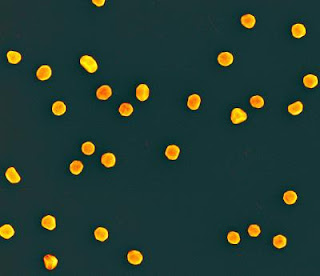The new NIST reference materials are citrate-stabilized nanosized gold particles in a colloidal suspension in water. They have been extensively analyzed by NIST scientists to assess particle size and size distribution by multiple techniques for dry-deposited, aerosol and liquid-borne forms of the material. Dimensions were measured using six independent methods—including atomic force microscopy (AFM), transmission electron microscopy (TEM), scanning electron microscopy (SEM), differential mobility analysis (DMA), dynamic light scattering (DLS), and small-angle X-ray scattering (SAXS). At the nanoscale in particular, different measurement techniques can and will produce different types of values for the same particles.
In addition to average size and size distributions, the new materials have been chemically analyzed for the concentrations of gold, chloride ion, sodium and citrate, as well as pH, electrical conductivity, and zeta potential (a measure of the stability of the colloidal solution). They have been sterilized with gamma radiation and tested for sterility and endotoxins. Details of the measurement procedures and data are included in a report of investigation accompanying each sample. ###
NCL examines candidate nanotech cancer drugs developed by biotech firms and academic labs. NCL and the NCI’s Alliance for Nanotechnology in Cancer sponsored the NIST work.
Additional technical and ordering information for the new NIST nanoparticle reference materials is available at:
- * RM 8011, Gold Nanoparticles, Nominal 10 nm Diameter
- * RM 8012, Gold Nanoparticles, Nominal 30 nm Diameter
- * RM 8013, Gold Nanoparticles, Nominal 60 nm Diameter
Technorati Tags: Nano or Nanotechnology and Nanotech or National Institute of Standards and Technology and National Cancer Institute’s Nanotechnology Characterization Laboratory or Discurso Radial del Presidente a la Nación 01/19/08 and Carter G. Woodson and An “attractive” man-machine interface















No comments:
Post a Comment